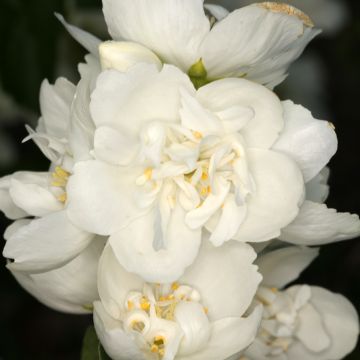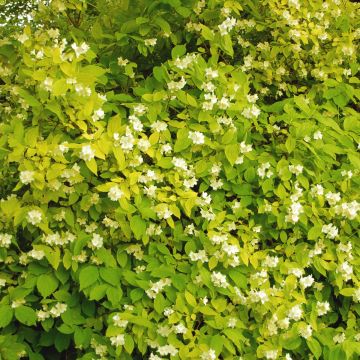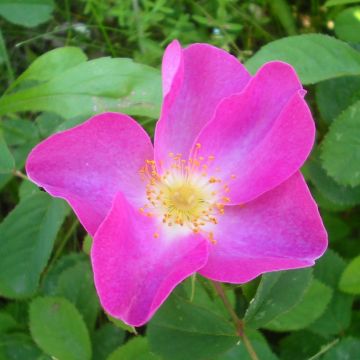

Philadelphus Snowbelle - Mock Orange


Philadelphus Snowbelle - Mock Orange


Philadelphus Snowbelle - Mock Orange
Philadelphus Snowbelle - Mock Orange
Philadelphus Snowbelle
Mock Orange
This item cannot be shipped to the selected country
Delivery charge from €5.90
Delivery charge from €5.90
More information
Schedule delivery date,
and select date in basket
This plant carries a 24 months recovery warranty
More information
We guarantee the quality of our plants for a full growing cycle, and will replace at our expense any plant that fails to recover under normal climatic and planting conditions.
From €5.90 for pickup delivery and €6.90 for home delivery
Express home delivery from €8.90.
From €5.90 for pickup delivery and €6.90 for home delivery
Express home delivery from €8.90.

Does this plant fit my garden?
Set up your Plantfit profile →
Description
The Philadelphus Snowbelle is a variety of mock orange with a rounded and compact habit that is distinguished by its particularly abundant double flowering in late spring. Its lightly scented flowers, which resemble white pom-poms, are so numerous that they almost hide the vegetation of this bush and gracefully bend its branches under their weight. Like all mock oranges, 'Snowbelle' is robust, hardy, and very easy to grow in ordinary soil, in full sun or partial shade. Plant it in a rustic flower bed or in a small free hedge, under a window, or even in a large container on the terrace!
The Philadelphus are all deciduous shrubs native to temperate regions of the Northern Hemisphere, particularly East Asia and North America. The approximately 60 species that make up this genus were first crossed in France by Lemoine and Jacques, and then in the United States, with the fragrance of the flowers sometimes being forgotten in favour of more spectacular, double blooms. Not demanding, mock oranges can sometimes take a while to establish. They should be regularly pruned after flowering, removing the oldest stems, to maintain a beautiful habit and ensure good flowering.
The Snowbelle mock orange is a horticultural hybrid obtained in 1961 by D.R. Sampson, in Ottawa, Canada. It is a bushy shrub with a dense and slightly arching habit, reaching an average of 1.50 m (4 ft 11 in) in all directions at maturity. It flowers in May-June depending on the climate. Its white flowers have up to 15 petals. They are rarely solitary, most often gathered in small clusters of 2 to 5 charming flowers. They are particularly numerous and emit a lightly intense scent reminiscent of orange blossom, which certainly explains why it is also called the "poet's jasmine". Its small, deciduous leaves are dark green, slightly toothed, and 3 to 5 cm (1.2 to 2 in) long. They are entire, arranged oppositely on the branches, and characterized by their ovate shape, pointed tip, and lighter longitudinal veins running through the blade. The foliage turns yellow and falls in autumn.
This Snowbelle mock orange, suitable for all types of gardens and very easy to grow, is ideal for beginner gardeners. It tolerates ordinary, even chalky and dry soil in summer. With a modest stature and a lovely rounded shape, it will be perfect in the background of perennial flower beds, in combination with other shrubs, at the forefront of a flowering rustic hedge, or even cultivated in a container on the terrace or balcony. Plant it near the house, terrace, or pathways to fully enjoy its intense fragrance. Planted in partial shade, it will illuminate the garden with the whiteness of its flowers. As its flowering period is relatively short, consider associating it with shrubs that bloom earlier or later (such as Deutzia, Buddleia, Forsythia, Caryopteris, lilacs). Let a small clematis climb in its branches, surround it with a The Fairy rose (in pink, red, or white), they will give a wild and charming touch to your composition. Its white flowering also allows for beautiful combinations with perennial plants that bloom in blue or white.
Report an error about the product description
Philadelphus Snowbelle - Mock Orange in pictures






Plant habit
Flowering
Foliage
Botanical data
Philadelphus
Snowbelle
Hydrangeaceae
Mock Orange
Cultivar or hybrid
Other Philadelphus - Mock Orange
Planting and care
The Philadelphus Snowbelle, very easy to grow, requiring very little maintenance and very accommodating, is well suited to all gardens and ideal for beginner gardeners. Ordinary soil, even limestone, is suitable for it. Planted in deep soil and partial shade, it withstands summer drought well in southern gardens. Very hardy, it can tolerate negative temperatures down to -20°C (-4 °F). Planting is done in early spring or autumn, preferably in full sun or partial shade. Excessive heat exposure should be avoided in dry and hot climates. Flowering on the previous year's shoots, Philadelphus should be pruned after flowering, in July-August, by shortening the branches that have bloomed by one third of their length. More severe pruning can be done every 2 to 3 years, to keep it compact and very floriferous. Simply do not hesitate to cut back the old wood and too long branches to the base of the plant to encourage branching from the base. A resistant bush, it can however be susceptible to powdery mildew and black aphids.
Planting period
Intended location
Care
-
, onOrder confirmed
Reply from on Promesse de fleurs
Foolproof Shrubs
Haven't found what you were looking for?
Hardiness is the lowest winter temperature a plant can endure without suffering serious damage or even dying. However, hardiness is affected by location (a sheltered area, such as a patio), protection (winter cover) and soil type (hardiness is improved by well-drained soil).

Photo Sharing Terms & Conditions
In order to encourage gardeners to interact and share their experiences, Promesse de fleurs offers various media enabling content to be uploaded onto its Site - in particular via the ‘Photo sharing’ module.
The User agrees to refrain from:
- Posting any content that is illegal, prejudicial, insulting, racist, inciteful to hatred, revisionist, contrary to public decency, that infringes on privacy or on the privacy rights of third parties, in particular the publicity rights of persons and goods, intellectual property rights, or the right to privacy.
- Submitting content on behalf of a third party;
- Impersonate the identity of a third party and/or publish any personal information about a third party;
In general, the User undertakes to refrain from any unethical behaviour.
All Content (in particular text, comments, files, images, photos, videos, creative works, etc.), which may be subject to property or intellectual property rights, image or other private rights, shall remain the property of the User, subject to the limited rights granted by the terms of the licence granted by Promesse de fleurs as stated below. Users are at liberty to publish or not to publish such Content on the Site, notably via the ‘Photo Sharing’ facility, and accept that this Content shall be made public and freely accessible, notably on the Internet.
Users further acknowledge, undertake to have ,and guarantee that they hold all necessary rights and permissions to publish such material on the Site, in particular with regard to the legislation in force pertaining to any privacy, property, intellectual property, image, or contractual rights, or rights of any other nature. By publishing such Content on the Site, Users acknowledge accepting full liability as publishers of the Content within the meaning of the law, and grant Promesse de fleurs, free of charge, an inclusive, worldwide licence for the said Content for the entire duration of its publication, including all reproduction, representation, up/downloading, displaying, performing, transmission, and storage rights.
Users also grant permission for their name to be linked to the Content and accept that this link may not always be made available.
By engaging in posting material, Users consent to their Content becoming automatically accessible on the Internet, in particular on other sites and/or blogs and/or web pages of the Promesse de fleurs site, including in particular social pages and the Promesse de fleurs catalogue.
Users may secure the removal of entrusted content free of charge by issuing a simple request via our contact form.
The flowering period indicated on our website applies to countries and regions located in USDA zone 8 (France, the United Kingdom, Ireland, the Netherlands, etc.)
It will vary according to where you live:
- In zones 9 to 10 (Italy, Spain, Greece, etc.), flowering will occur about 2 to 4 weeks earlier.
- In zones 6 to 7 (Germany, Poland, Slovenia, and lower mountainous regions), flowering will be delayed by 2 to 3 weeks.
- In zone 5 (Central Europe, Scandinavia), blooming will be delayed by 3 to 5 weeks.
In temperate climates, pruning of spring-flowering shrubs (forsythia, spireas, etc.) should be done just after flowering.
Pruning of summer-flowering shrubs (Indian Lilac, Perovskia, etc.) can be done in winter or spring.
In cold regions as well as with frost-sensitive plants, avoid pruning too early when severe frosts may still occur.
The planting period indicated on our website applies to countries and regions located in USDA zone 8 (France, United Kingdom, Ireland, Netherlands).
It will vary according to where you live:
- In Mediterranean zones (Marseille, Madrid, Milan, etc.), autumn and winter are the best planting periods.
- In continental zones (Strasbourg, Munich, Vienna, etc.), delay planting by 2 to 3 weeks in spring and bring it forward by 2 to 4 weeks in autumn.
- In mountainous regions (the Alps, Pyrenees, Carpathians, etc.), it is best to plant in late spring (May-June) or late summer (August-September).
The harvesting period indicated on our website applies to countries and regions in USDA zone 8 (France, England, Ireland, the Netherlands).
In colder areas (Scandinavia, Poland, Austria...) fruit and vegetable harvests are likely to be delayed by 3-4 weeks.
In warmer areas (Italy, Spain, Greece, etc.), harvesting will probably take place earlier, depending on weather conditions.
The sowing periods indicated on our website apply to countries and regions within USDA Zone 8 (France, UK, Ireland, Netherlands).
In colder areas (Scandinavia, Poland, Austria...), delay any outdoor sowing by 3-4 weeks, or sow under glass.
In warmer climes (Italy, Spain, Greece, etc.), bring outdoor sowing forward by a few weeks.























































